Dr Peter Ridd compiled the statistics on coral reefs around the world, and even though China has installed a million megawatts of coal fired power in the last twenty years, there’s no evidence that corals are suffering significantly.
Statistics on corals barely existed before 1980, and didn’t get semi reasonable until 1998 or so. But with twenty years of data there is no evidence suggesting we need to send in the SWAT teams with floating shade sails, giant fans, breeding teams, or sunscreen for staghorn coral.
We do however need to send in the SWAT team to rescue our universities.
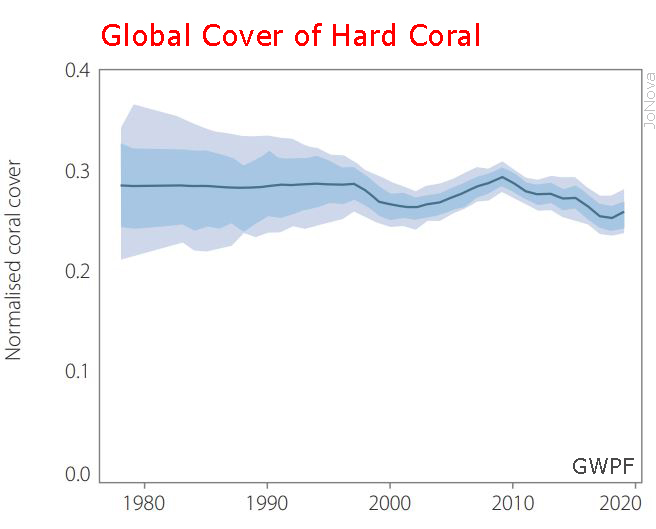
Hard Coral around the world is not suffering a mass die-off due to climate change, GWPF
Bleached is not killed
Academic shaman have implied (tacitly) that bleached coral is like dead coral, but instead bleaching is more like home redecoration and the corals recover surprisingly fast. But amongst all this noise of loss and recovery, and with such short term data it’s been hard to see the big picture.
The uncertainty bars on early coral studies expand like an emergency flare. But notice that there is no significant, distinctive response from corals despite CO2 being a well mixed gas spread all over the world. Where CO2 looks bad for some reefs one decade, it looks good the next. It’s almost like corals are being affected by something else entirely…

GWPF, Peter Ridd, 2023 (click to enlarge)
Peter Ridd takes a closer look at the four most important regions of corals, and the news for marine life is good.

Hard Coral Cover of the East Asia Region, GWPF
Why fear warming when corals love the hottest large water body on Earth
The area of most coral diversity, the ‘Coral Triangle’, in the seas around Indonesia, Papua New Guinea and the Philippines, is located at the centre of the Indo-Pacific Warm Pool – the hottest large water body on earth. This is not a coincidence. For every 1°C reduction in water temperature, there is a roughly 15% reduction in growth rate. Corals are also found in colder water, such as Scotland and Alaska, but their growth rate in these places is so slow that they are unable to form reefs.
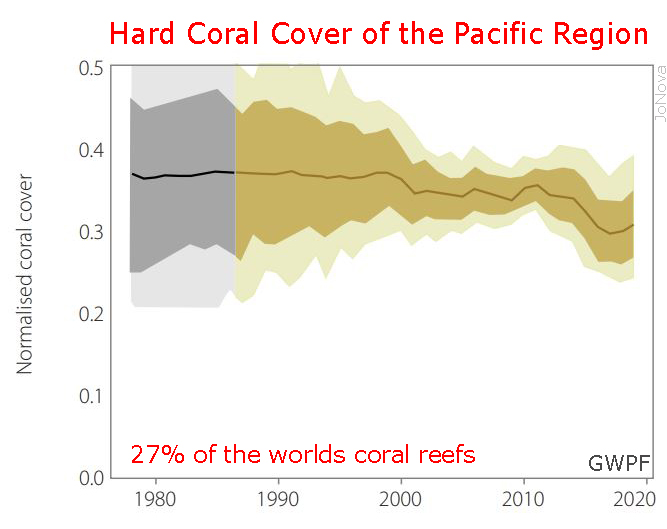
Hard Coral Cover of the Pacific Region, GWPF
Because most of a reef is underwater, determining longterm changes in condition is difficult; historical archives of aerial photographs cannot be used.11 This is in contrast to monitoring the decline of the world’s tropical rainforests, where clearing of rainforests has been documented for about a century. The reduction in rainforest extent in Africa, Asia, and South America can be easily inferred from old maps and modern aerial photographs.
Compared to rainforest loss, reefs are almost untouched
To put this in perspective — we know we’ve lost half of the Australian rainforest yet all 3,000 reefs off Queensland are still there:
For example, Google Earth images can be used to infer a 50% loss of Australian tropical rainforest, and almost total loss of lowland rainforest, since the European settlement, due to clearing for agriculture. Farms are now located where rainforest would once have been. However, for the GBR, all that can be said is that there has been no physical destruction of any reef on the scale of clearing for agriculture. All 3000 of GBR‘s reefs still exist, and all have coral on them.
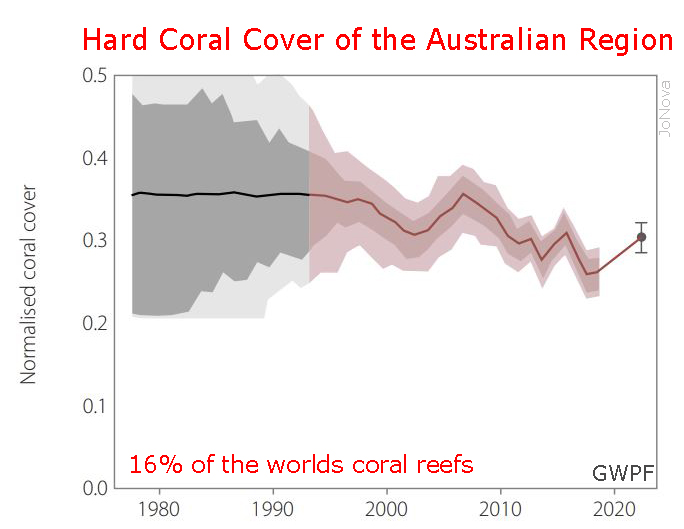
Hard Coral Cover of the Australian Region, GWPF
Lord help us, it’s hard to get good data
Data for Australian corals is probably the best in the world, but despite effectively surveying a strip of coral 1,000 kilometers long every year, the Great Barrier Reef is so large we are only sampling 0.003% of the total area.
In order to appreciate the magnitude and difficulty of the task of monitoring reef systems, it is useful to consider the GBR, which has, by far, the most comprehensive monitoring program in the world. Carried out by the Australian Institute of Marine Science (AIMS), the ‘Long Term Monitoring Program’ (LTMP) only started in the mid-1980s – sporadic data exists for earlier periods, but is too limited for determining long-term trends. The GBR is huge – larger than Germany and as long as California – and has 3000 individual reefs, each a few kilometres across. AIMS surveys roughly 100 of the reefs each year using Manta tows, which means they cover roughly 1000 km each year. Despite this huge distance, the area surveyed represents only roughly 0.003% of the total area of the marine national park. In addition, AIMS covers around 100 small set transects with benthic surveys.
The Caribbean reefs have survived three million years of climate change
The coral cover in the Caribbean is lower than other regions, but hasn’t changed much in the last twenty years. The region has been separated from other coral regions for three million years — so has evolved on its own path. It’s hard to say if the lower coral cover is due to human or other damage that may have started long ago, or is just because these reefs have a different mix of species.
In any case, it doesn’t correlate with CO2 either.

Hard Coral Cover of the Caribbean Region, GWPF
Fast coral recovery is written off as “just the quick growing species”
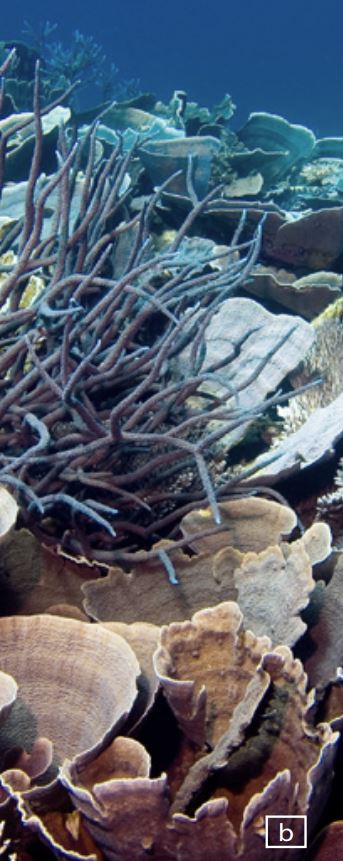
These are fast growing and delicate ‘plate’ and ‘staghorn’ corals that are
extremely susceptible to damage by storms and starfish plagues.
When corals recover fast the academics and media imply that the new growth is somehow not as good or strong as what was lost. But as Peter Ridd points out they can’t have it both ways. These fast growing species are the same ones that got hit in the bleaching episodes in the first place. Slow growing corals are tougher and harder to bleach. So the new fast growing corals are just replacing the injured fast growing corals.
Some corals like to live fast and die young
These corals use bleaching as a strategy to adapt to different conditions.
Some ‘high octane’ zooxanthellae will allow the coral to grow fast, but will make it more susceptible to bleaching from high temperatures. ‘Low octane’ zooxanthellae will make it grow slowly, but leave it less susceptible to bleaching.
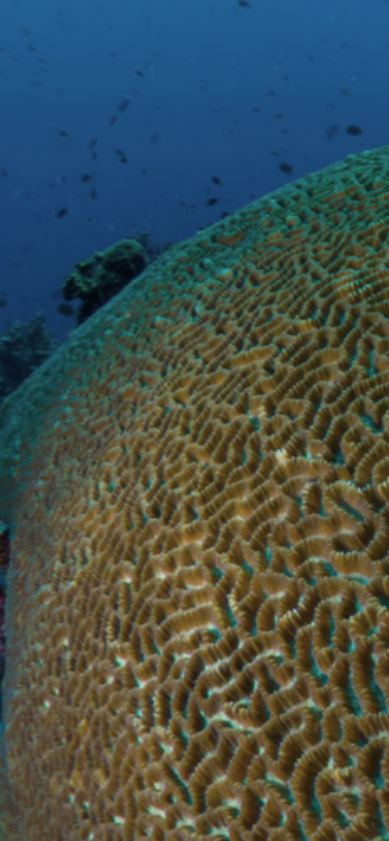
An example of a ‘massive’
coral. These are slow growing but can live for centuries. They are relatively unsusceptible to bleaching.
The life strategy of many corals, particularly the light and delicate ‘plate’ or ‘staghorn’ corals (Figure 1b), is to live fast and probably die young. They produce a lightweight calcium carbonate skeleton, which means that they will probably be obliterated by a tropical cyclone within 20 years. They are also highly prone to being eaten by crown-of-thorns starfish. As it happens, the return incidence for bleaching events and cyclones is often roughly the same and it is probably no coincidence that these physically delicate and easily damaged corals are the most susceptible to bleaching, and have a life expectancy of just a couple of decades. Taking on high octane zooxanthellae and growing quickly, while risking death by bleaching, is all part of their life strategy. At the opposite extreme are the massive corals that can live for centuries and become a solid block of calcium carbonate, metres across, and weighing tons. These grow more slowly, and will generally pass through a cyclone/hurricane relatively unharmed and are less affected by starfish plagues. They have a long-term strategy, and quick death by bleaching is not part of it.
Bleached is not the same as dead coral
These reefs recovered so fast they could not have been killed in the first place. A coral that has been killed will need ten years to recover, but a bleached one is just redecorating with newer better zooxanthellae.
While they [fast growing corals] can indeed regrow extremely rapidly (within a year) from a small section that is left alive (the so-called ‘phoenix effect’), if they are killed, recruitment of larvae and regrowth takes 5–10 years. They cannot regenerate within a few months. The rapid recovery of the reef cover therefore shows that they were bleached, but not killed. In other words, the past few years’ data has proven that very little coral was killed by the bleaching events – even the fast-growing coral that is most susceptible. Coral reefs can double or even quadruple their coral in a decade. The loss of a few percent from bleaching is a minor disturbance.
Coral comes pre-adapted to climate change
Few other organisms have this type of adaptability to changing temperatures. Whereas many organisms take generations to alter their genetic make-up, corals can adapt to changing temperatures in a few weeks, simply by switching zooxanthellae during bleaching. Corals thus have a remarkable, almost unique, ability to deal with changing climates. Are they the ‘canary in the coal mine’, or one of the toughest organisms on earth, or somewhere in between?
Academic tricks to make an 8% death rate seem like 93%
The legendary 2016 bleaching was essentially word-game hyperbole:
… it was widely reported that the 2016 bleaching event of the GBR affected 93% of reefs, with the implication that there was a 93% coral loss. However, if a reef had only a very small amount of bleaching, it was classified as one of the 93% of reefs that bleached…
The best estimate for total coral loss on the GBR during the 2016 bleaching event is that, at most, about 8% died. Almost all of this was in very shallow water, less than 5 meters deep.
Frade et al. (2018) showed that coral loss in water between 5 and 40 m depth was about 3%. Figure 4 demonstrates without doubt that the coral loss was small compared to the regeneration capacity of the reefs. Although there is no doubt that a significant amount of coral was killed by bleaching in 2016, it was far less than can be destroyed by a major cyclone, and far less than what was effectively reported by the media. This confirms previous work by De’ath et al. (2012) who found that cyclones and starfish plagues are responsible for 90% of coral mortality, and bleaching just 10%.
The bottom line: The Reefs may or may not be fine, but science is in trouble
Although it is extremely encouraging news, the latest statistics about coral reefs around the world, and especially recent ones from the GBR, do not prove that the world’s reefs are all going to be fine. However, they prove without any shadow of a doubt that the coral reef science community, with a few exceptions, is lacking in scientific integrity. They have cried wolf too often.
REFERENCE
Peter Ridd, (2023) Coral in a Warming World, Causes for Optimism, GWPF, February










Heard on their ALPBC the other day that “scientists” had
“discovered” a very healthy coral reef off Maroochydore.
That’s amazing!
230
Coral reefs grew further south in Western Australia during the warmer Eemian inter-glacial.
Of course sea levels were higher as well during the Eemian and also sea temps.
Again thanks to Jo Nova, Jennifer Marohasy and Peter Ridd etc for showing us that the Corals are dying BS isn’t as dire as the extremists claimed and Corals also love the much warmer waters further north of the GBR.
320
Indeed.
All these warmists who proclaim “coral bleaching” but have never bothered to visit the reef, or at least the relevant parts of it rather than locations of isolated natural bleaching events (a perfectly normal phenomenon).
Which is odd, because warmists and fellow parasites don’t generally miss the opportunity of a fossil-fueled taxpayer-funded adventure holiday to an exotic (and usually warm) location…. In fact, they probably go anyway but just forget to tell the truth about what they see.
210
Very few people have actually visited the backbone of the GBR, the Outer Reef in the east of it all.
Far more people have had a look, mostly brief, at some of the small reefs that fringe the few islands close to the coast and open for tourism.
When we lived in Townsville and for years after, we tried to get to the Outer Reef, but failed every time. Too rough for fast small boats, too rainy or windy for amphibious aircraft, all sorts of reasons prevented a look. It is a long day to get there and back and there are no big resort hotels out there, so almost always it is a day trip unless you have your own yacht.
Geoff S
60
Good article. In my region, North of the Whitsunday Group, most observers like anglers and divers don’t see a problem, although all recognise the threat of Crown of Thorns and Tropical cyclones pose. You hear most of the bleating from the eco-tourism side who play to their usually young clients – plus some gullible oldies. Some people see the inner reefs which are largely drab green and mauve and think it dead. To be sure, the GBR is a treasure of wordlwide significance and it’s a pity that so much politics are played around it.
260
The Crown of Thorns starfish might be unpleasant and damaging and look ugly and not suitable for tourist brochures but I don’t believe anyone has ever proven it is not natural and doesn’t belong there. Why attempt to control nature?
240
“Why attempt to control nature?”
Have you SEEN nature?! Most of mankind’s efforts over its existence has been towards stopping nature from killing us.
(So, yeah, “controlling nature” sounds like a Public Broadcasting Service anti-slogan, but it’s not that bad a thing.)
100
Nature doesn’t need any help from us. In the mid 70s I lived & worked in New Guinea & the Solomons. I cruised my yacht through out plus the Gilbert Ellis & Caroline islands among many.
I visited ex patrol boat bases, where not a thing was left from the large developed bases of the late 1940s. On the Treasury Islands I found cement steps from water level up a few feet to nowhere. A very faded sign said “Officers Club”, but there was no sign of any structure in the jungle.
The air strip could not be found, but I did find a 30Ft diameter, 6Ft high pile of rust that had once been 50 cal aircraft machine guns, with palms growing out of it.
At Kana Cope I found rows of breaking up 4Ft thick cement slabs which had once been a major repair base with heavy machine shops. Trees were growing out of many of the slabs.
I can’t help laughing when ever some fool talks about fragile nature. It is us & our works that are fragile, disappearing in just 30 years.
110
I recall the ABC did a segment about the starfish “plague” on the ‘This Day Tonight’ show in the early 70’s. Scenes of divers loading up boats with them. We should have realised that was nature at work and stop being emotional about it.
80
The Crown of Thorns starfish supposed “plague” has been a wonderful source of funding for “researchers” for decades, as well as taxpayer funded adventure holidays in the tropics complete with free remote island stays, scuba diving, helicopter and boat rides.
90
In Tahiti, the starfish has been welcomed for hundreds of years as it refreshes the reef with pruning. They celebrate its arrival and have songs of praise.
It is only our ‘discovery’ of the starfish and automatic labeling it as destructive which has created a fake crisis. The University at Townsville were working on a robotic and autonomic swimming drone which would recognize the crown of thorns starfish and inject cyanide . Now how could that possibly go wrong?
80
And what has happened to Malcolm Turnbull’s massive gift unrequested of $444million (7 tons of gold) to his wife’s committee to ‘save’ the Great Barrier Reef? They had no idea what they were going to do with the money nor had they applied. However after saying they would spend $134Million on administering the cash (6 people) they were going to deal with the starfish and of course Climate Change.
Where’s the money?
100
Or at least a brief report on how much has been spent and on what.
00
TdeF, not to be too picky but out of curiosity I looked at 2019 gold prices and todays USD to AUD and got 9.2 tonnes of AU, that is shocking.
20
I couldn’t find the TDT video online but found this “short” on YouTube. “Maybe no one was looking”.
https://youtube.com/shorts/WgJAloFZPbg?feature=share
60
Why isn’t anyone worried about the possibility of the reef shrinking, or at least moving north as the world cools?
According to the reference below tolerance temperature for warm water corals is 21.7—29.6 °C.
The warmists have a Medieval world view, they don’t understand that our world is constantly changing due to natural forces.
And do they ever wonder how ancient coral reefs ended up above sea level, numerous examples of those? I doubt it. It doesn’t fit their “static world” beliefs.
Reference:
https://www.ncbi.nlm.nih.gov/pmc/articles/PMC4452591/ (but note funding from China Scholarship Council).
190
BTW there has been little change in the rate of SLR over the past century and no evidence of recent SLR acceleration at all.
So when will we ditch the extremist’s TOXIC, UNRELIABLE S & W disasters and only build reliable BASE-LOAD energy for Australia’s future requirements?
https://notrickszone.com/2023/02/07/sea-level-is-stable-around-the-world-the-good-news-the-media-dont-want-us-to-hear/
180
Tabloid headline:-
Shout out ’bout the OK coral.
80
Re medieval world view ~ the medievals all saw this world as changeable/always changing – for instance Augustine https://brians.wsu.edu/2016/11/14/st-augustine/ and Boethius https://sourcebooks.fordham.edu/source/con-phil.asp (This becomes clear when we consider temporal things: whatever lives in time lives only in the present, which passes from the past into the future, and no temporal thing has such a nature that it can simultaneously embrace its entire existence, for it has not yet arrived at tomorrow and no longer exists in yesterday. Even one’s life today exists only in each and every transient moment. Therefore, anything which exists in time . . . cannot properly be considered eternal, for anything in time does not embrace the infinity of life all at once, since it does not embrace the future or the past.)
no the greenies suffer from a uniquely modern philosophical blindness – they consider earth as equivalent to God, an eternal being with a will that punishes miners and people who don’t recycle their plastic bags.
20
Yes, it’s a bun fight about OK Coral
110
Adellad,
Headline right there . Well done .
20
Cool. They’re not dying off, they’re dyeing off.
110
That plural is shamans, not shamen, Jo. Just so you don’t get corrected by know-it-alls. I will delete this comment promptly.
[Thanks. I stand corrected. – Jo]
80
Are you shamen her?
80
Doh! I got up this morning with the intention of completing some jobs around the house ( couple of days off) and firstly I started reading a Robert Malone sub stack article on how the US blew up the Nordstream pipeline. Then this really informative article. Look at the clock and a whole hour has gone by. Don’t you just love Peter Ridd? The man deserves a knighthood.
211
Thanks Peter Ridd.
130
The IPWP coral tells a story of more salinity during the LIA, while fresher conditions came with global warming.
‘Two centuries of climate reconstructions record cool/dry conditions at the end of the Little Ice Age and warm/fresh conditions in the late twentieth century to the present.’ (Ramos et al 2020)
50
Focussing on the Western Pacific Warm Pool (the world’s heat engine) what happened to to the corals during the LIA? The Eastern Pacific El Nino is a Modoki.
‘Furthermore, we highlight the implication of WPWP on El Niño diversity with a greater probability of EP-type El Niño under a colder WPWP state and successive westerly wind bursts. As such, the cold state of WPWP can provide an effective modification for the earlier operational prediction on El Niño intensity and flavors. On the contrary, the warm WPWP state may not be useful for future La Niña alerts.’ (Chen et al 2021)
40
One final point, corals are a useful tool to study past climate. On the southern edge of the warm pool in New Guinea they discovered a cyclic phenomenon.
‘These time series contain abundant interannual variability that exhibits the well-recognized pattern of low amplitude ENSO variation between similar to 1920-1960 and high amplitude ENSO variation between 1880-1920 and 1960-1997. ‘ (Quinn et al 2006)
50
Peter Ridd can be assured that he is on the right side of the science/culture war. There are too many Marine Scientists these days who also know how to milk the public purse. Oh, and the unaccounted 444million.
120
I would like to see a full public accounting of how that was spent and which companies profited (and who they are owned by), including possibly inflated salaries paid to “researchers”.
111
If cyclones do more damage to coral than warmer water does and given cyclones have statistically reduced over the last 50 years (supposedly as part of climate change) then shouldn’t those concerned about the reef be cheering for more CO2 and more climate change for even less cyclones?
90
Thanks for reminding us Strop and here’s the BOM Aussie cyclone trend since 1970.
Note that both severe and non severe cyclone trends are lower over that period. And the 2015 to 2016 season is the only 12 month period without a severe cyclone.
http://www.bom.gov.au/cyclone/climatology/trends.shtml
60
In fact, cyclones are part of nature’s cleansing mechanism to remove mechanically weak and unstable coral structures. Without them, the reef may accumulate weak, unstable corals.
60
I think a large part of the problem is students entering this “environmental science” degree stuff, are activists before they start. Then once they have their honours ticked off they really think they are going to prove the earth is dying because they are now scientists.
At least that’s how I used to think when I had an activist mindset who went through it. But that was back when no one was really into climate change. Our lecturers refused to talk about it back then – late 80s early 90s. I suspect that is not the case anymore.
90
Yes.
“Environmental science” degrees are rapidly gaining the same reputation of uselessness and anti-intellectualism as “degrees” in “gender studies”, “queer theory” or “critical race theory” and similar.
At least among the thinking community.
121
My Firstborn has a “science” degree. He obtained this without completing any units in physics, chemistry, biology or maths. He majored in Eco-Feminism.
Yes, really.
140
Wow, things have deteriorated. That is funny though at least.
70
It’s been going on for a long time, Philip.
Firstborn completed his “science” degree over twenty years ago.
110
thankfully in Australia no such course has ever existed
01
Memoryvault, I find that very sad.
20
Yes David, I did too when I first met him in 2010.
By then he was 41 and I was 58. A bit late to try and change things.
30
A funny story from my university environmental science days – that shows how misplaced minds are by default when it comes to science and the environment.
The course was Vegetation Management and we had to develop a veg management plan for a local area. Everyone had just finished Plant Taxonomy 211, so all people wanted to do was identify plants.
We were allocated into teams, and my team became fixated on finding a rare plant via identifying all plants in the area. After a few very tiring days and time running out quickly I had to speak up and said this is a waste of time, the subject is veg management not taxonomy and finding a rare plant is not the aim here.
Well, this did not go down well, they couldn’t comprehend what I was talking about. They continued the fruitless exercise (democracy) and produced a meagre list of plants (no rare one, most unidentified) and the “management plan” was one sentence at the bottom of the poster, “to burn it like the aboriginals did’.
The point is, people become fixated upon a result they want, and they will not stop until the result is achieved (or time runs out). I see connection between this attitude and the coral. Our wanted result was “there is a rare plant here and we must find it”. For the coral the fixation is that these reefs are dying and we must prove it. Their minds are made up before they start.
130
As John Heywood wrote in 1546, another way of saying:
From him who sees no wood for trees
And yet is busie as the bees
From him that’s settled on his lees
And speaketh not without his fees.
30
Corals are doing fine. The buffering action of sea water regulates CO₂ absorption from the atmosphere via the process of chemical equilibrium so that corals always have the right amount of CO₂ with which to build their calcarious skeletal structure. What a pity that scientists, other than Peter Ridd and a few others, want to hex the knowledge of this wonderful phenomenon with their grant and wokium driven AGW witchcraft.
30
No amount of ‘the World is not coming to an end’ good news is going to change the cultural and political situation.
The cult is too strong.
The young are thoroughly brainwashed.
The Dark Age of Scientism is upon us.
Odd and sad that science did this to itself.
100
We were just talking of this this morning, the young are brainwashed by the age of 8. I know a kid of 12 years old, who has zero interest in environment or politics or anything like this – he just games 247 in a darkened room – but he gets a bit upset when he hears adults talking negatively about Greens and climate change (that’s me, so I have to shut up when he’s around). He’s been brainwashed thoroughly with zero interest in the topics. An astonishing achievement by the education department. In 6 years, he votes.
100
No HR, it was money that did this.
60
Science didn’t do it.
It was a predictable consequence of taxpayer funded science.
It is a corruption of science.
Eisenhower warned about this in 1961 in his famous farewell address.
EXTRACT
40
“Although there is no doubt that a significant amount of coral was killed by bleaching in 2016,”
This was due to exposure due to very low tides due to the large El Nino.
The very opposite of “sea level rise”
It had absolutely nothing to do with atmospheric CO2.
60
It’s time to leave corals be,
To do their own thing in the sea,
While through bleaching they thrive,
And worldwide survive,
It should not trouble you or me.
90
Reefs are carbon sinks (all life is). Cognitive dissonance rules . A hard lesson is coming .
40
It was interesting to hear Tanya Plibersek say that they had to reject Clive Palmers coal mine in order to protect the reef. She said that it could put tourism jobs at risk. What does she think that the activist politicians and bureaucrats have done to tourism by their false claims that 90% of the reef had died. The coal industry isn’t killing the reef, scientists and academics making false claims are.
I would’ve thought the current good health of the reef ( despite a number of existing coal mines in the vicinity) would’ve been a good time to have a big marketing campaign for the reef but a healthy reef doesn’t suit the narrative.
50
The coming hurricane of popular anger will kill off 93% of the corrupt coral reef academics.
30
Plibersek (like Bowen) couldn’t think to save her life. Australians will be paying for this dumb duo for decades to come.
10
I realize that they sre talking about temperature here, but I’ve long been amused by another obvious problem with their silly hypothesis.
In the absence of dissolved CO2, there’d be no coral.
“Massive reef structures are formed when each individual stony coral organism—or polyp—secretes a skeleton of calcium carbonate.”
https://oceanservice.noaa.gov/facts/coralmadeof.html
So, naturally, CO2, the feedstock of the carbonate, must certainly be bad for corals, right? 🙄
30